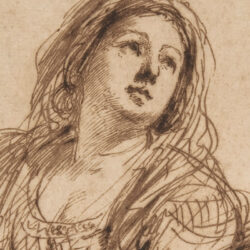In the mid to late 18th century, London was a thriving market for interior designers. Wealthy patrons were seeking the most fashionable and distinguished decoration. This was answered by talented architects and craftsmen who could create entire schemes inclusive of furniture, murals and decorative objects.
 Above: our team working on a Robert Adam ceiling in Mayfair
Above: our team working on a Robert Adam ceiling in Mayfair
Scottish architect William Adam and his sons Robert and John were part of this flourishing scene, providing much coveted neoclassical tastes to country estates and town houses throughout Britain. Their work became so synonymous with a pastel colour palette and hellenistic fashion that it would become known as The Adam Style.
 Above: a selection of designs by Robert Adam, 18th century
Above: a selection of designs by Robert Adam, 18th century
Our team has encountered numerous Robert Adam interiors and decorative objects related to his iconic style. This article will look into the allegories of neoclassicism, as well as the conservation work we have undertaken.
 Above: a recreation of a Robert Adam dining room in miniature form
Above: a recreation of a Robert Adam dining room in miniature form
The Bohemian Room, 30 Curzon Street
By the 1770s, Robert Adam interiors could be found in all of the most fashionable London settings, including newly constructed terraces in Mayfair. Our conservation team was called upon to restore a ceiling and motifs designed by Robert Adam at 30 Curzon Street.
Curzon Street was constructed around 1770, the interior was designed by Robert Adam in 1771-72. The Bohemian Room is on the first floor and is today one of the last remaining areas where the original Adam scheme remains. The Bohemian Room’s decorative moulded plaster was undertaken by Adam’s plasterer Joseph Rose Junior – a celebrated craftsman whose neoclassical work can still be seen in stately homes around the country. He had worked closely with Robert Adam from 1760 onwards.
 Above: two interior designs for Headfort House by Robert Adam, 1771-75
Above: two interior designs for Headfort House by Robert Adam, 1771-75
After carrying out a thorough investigation of the original paint layers, our conservators were able to bring the interior back to life with historic accuracy. The room would function as part of Crockfords Club, an exclusive casino with esteemed clients. The revival of the neoclassical ceiling would not only aid in historic preservation, but with their unique and majestic ambience.
The barrel vaulted ceiling of the Bohemian Room at 30 Curzon Street has seen many influential figures as its residents in the centuries since its creation. The design by Robert Adam is typical of his style, encompassing a frequent use of ornamental motifs, small fresco paintings with classical themes and a traditional ‘Adamesque’ palette of light green, pale blue, pastel pink and soft white.
 Above: a detail of the ceiling containing the figure of victory and four profiles of ancient philosophers
Above: a detail of the ceiling containing the figure of victory and four profiles of ancient philosophers
The first features to stand out when you view the ceiling are the decorative murals contained within the gilt decoration. The central painting features the ancient deity Eros with Venus or Psyche – emblematic of love, beauty and desire. A side mural depicts a figure of Nike, the goddess of victory, flying towards the subject she is about to crown with a wreath of flowers. Several aspects of the Bohemian room include putti (child-like angels), these are a typical symbol of a divine presence. Smaller murals include side profiles of philosophers and trompe l’oeil reliefs of The Virtues or Muses.
Neoclassicism was a prevalent theme in homes and establishments across the United Kingdom in the late 18th century. This revival of Grecian and Roman forms was compelled by the enlightenment period, bringing ancient imagery, philosophy and literature into the forefront of the aristocracy’s consciousness. Not only did this glorify the remarkable skill of ancient design, but allowed the inhabitants of such an interior to see themselves as the modern continuation of imperial power and classical ideals.
 Above: the mural of Nike – goddess of victory
Above: the mural of Nike – goddess of victory
Another of the paintings is of Hebe, the goddess of youth, as she feeds ambrosia to Zeus (who is in the form of an eagle). Ambrosia is the nectar of the gods and was said to keep them immortal. Hebe was a very popular character in art from 1750 to 1880, especially in this pose with an eagle companion. As well as youth, Hebe is also implicative of good marriage as she was later the wife of Heracles. Due to these connotations, aristocratic women were often depicted as Hebe in historically-inspired costume portraits, as seen in work of this period by François-Hubert Drouais, Sir Joshua Reynolds, Angelica Kauffman, Gavin Hamilton and Marie Antoinette’s court painter Elisabeth Vigée-Lebrun.
The inclusion of Hebe, Eros, and Nike are both a fashionable and allegorical choice by Robert Adam, who is using their divine presence to indicate the good fortune of those who live at 30 Curzon Street. By classical association (one that would have been exclusively understood by educated aristocrats of the era) the interior is able to create a carefully curated message that reflects the triumph in love, marriage, education and high social position.
 Above: roundels containing a philosopher and the goddess Hebe with Zeus in the form of an eagle
Above: roundels containing a philosopher and the goddess Hebe with Zeus in the form of an eagle
The Bohemian Room Restoration
The painted panels of the ceiling required the most preparation and repair work of the project. The heavy paint layers and thin plaster had failed in many areas and had created lifting cracks. This required careful removal to begin consolidating any areas of cracking. The gaps were then filled and sanded smooth to the curve of the ceiling.
 Above: the ceiling of the Bohemian Room at 30 Curzon Street
Above: the ceiling of the Bohemian Room at 30 Curzon Street
Any areas of cosmetic cracking (cracks to only upper paint layers) were also stabilised. Any cracks to ribs (the thin ribs that bordered the walls and ceiling, and extension area) were filled with caulk as these were liable to shift with temperature fluctuations and required a more flexible filler to prevent future deterioration.
Our team discovered many raised areas of poor paintwork from unprofessional restoration attempts, likely layered across many decades since the ceilings initial creation. These were sanded smooth where possible or filled to create a level surface.
 Above: our conservator working on the cracked areas of paint
Above: our conservator working on the cracked areas of paint
Once the ceiling panels were appropriately prepared, our conservators began mixing pigments to colour-match the original decoration. Overall, five colours were recreated to ensure the interior was as true to Adam’s original vision as possible.
The figurative roundels provided the most complex treatment of the project as they required a combination of traditional easel painting conservation methods with decoration techniques. Adam used artists to complete these pieces off-site and had them installed at a later date. The Bohemian Room roundels were composed on paper in oil paint and varnished for protection. A number of the decorative roundels were lifting or delaminating so it was essential to re-adhere these so that the paintings were secure for the next phases of conservation. Stabilisation was carried out with a conservation grade adhesive, injected behind the paint using a syringe.
 Above: a painted roundel being stabilised, tested and cleaned
Above: a painted roundel being stabilised, tested and cleaned
Once stable, the roundel decorations were cleaned. They had been coated in thick, discoloured varnish which had kept them protected from the atmospheric dirt and contaminants and nicotine. However, the images were being obscured by this layer. Surface cleaning was carried out using deionized water and cotton wool swabs, one inch at a time. The varnish layer was tested for the most appropriate solution and removed using the safest solvent. The varnish layer had been applied unevenly and poorly in the past, making this a long and intricate process for our conservators. The varnish removal took away other historic restoration attempts, such as unoriginal paint layers. These areas were sensitively retouched before a new conservation-appropriate varnish was applied.
 Above: photographs of the work in process, taken by our conservation team onsite at 30 Curzon Street
Above: photographs of the work in process, taken by our conservation team onsite at 30 Curzon Street
Gilding was carefully cleaned with small amounts of cotton wool to minimise abrasion to the delicate gold leaf. The initial clean removed decades of atmospheric dirt and nicotine, the cotton wool balls were coming away from the gold covered in thick black dirt. The second round of cleaning was completed after the preparation and painting of the ceiling to ensure that any stray paint was removed, dust was lifted, and any areas that had been missed were cleaned.
 Above: intricate decorative elements being addressed prior to gold leaf restoration
Above: intricate decorative elements being addressed prior to gold leaf restoration
There were some areas of historic damage to the gilding and parts that had been painted rather than gilt. Uneven areas were toned in using an appropriate gold watercolour, creating a much more unified look from the ground. The eventual result was a cohesive and historically accurate finish, well-preserved and ready for the casino patrons to return to their beautiful venue.
How can we help?
If you have any questions about Robert Adam interiors or art restoration, please do not hesitate to get in touch. As part of our service we offer a nationwide collection and delivery service. E-mail us via [email protected] or call 0207 112 7576 for more information.

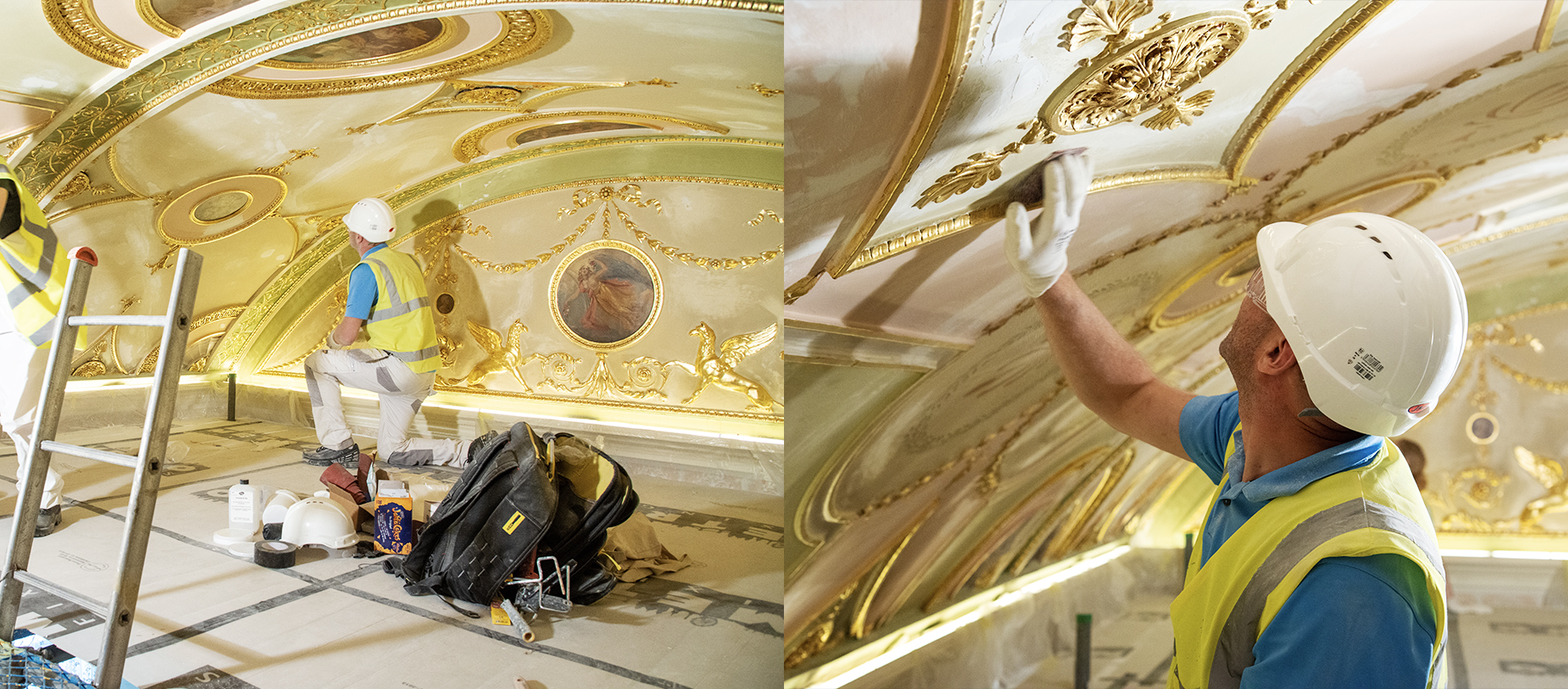 Above: our team working on a Robert Adam ceiling in Mayfair
Above: our team working on a Robert Adam ceiling in Mayfair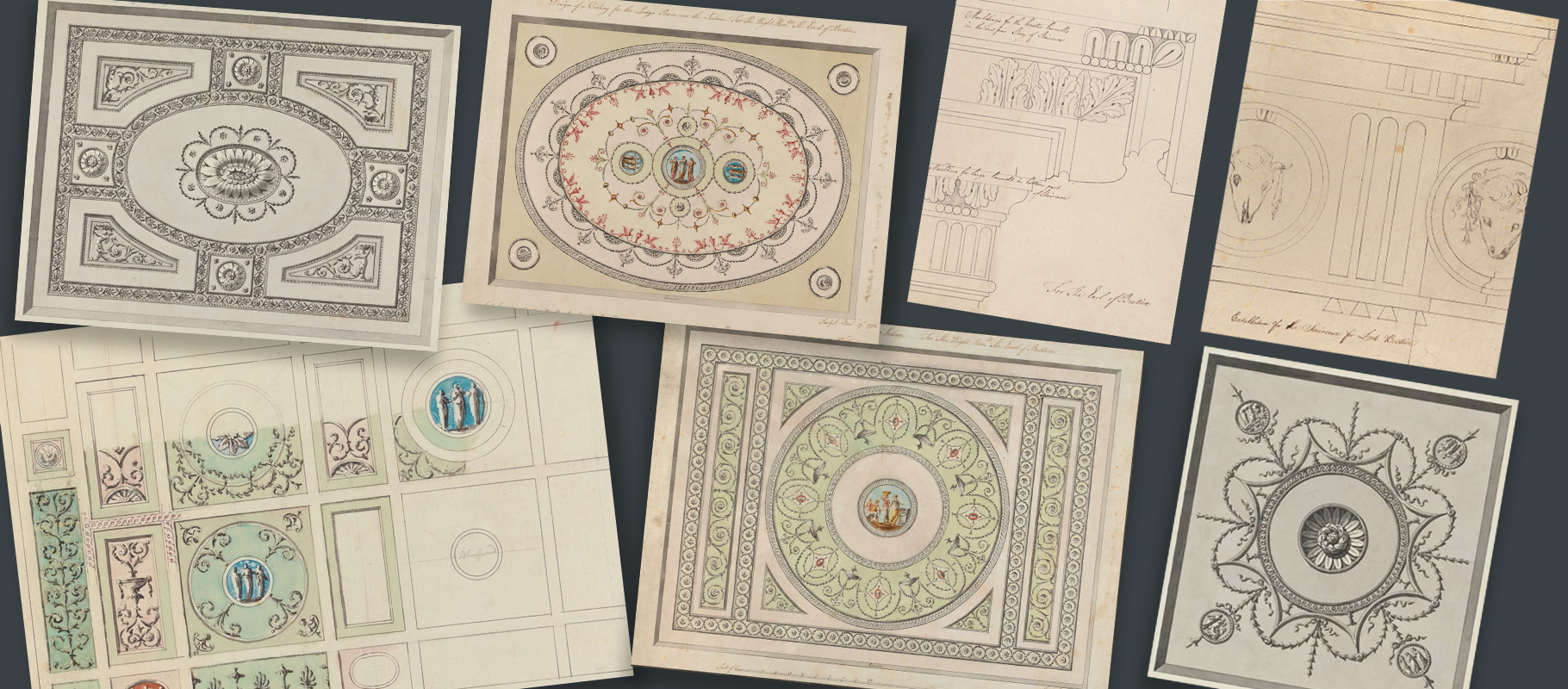 Above: a selection of designs by Robert Adam, 18th century
Above: a selection of designs by Robert Adam, 18th century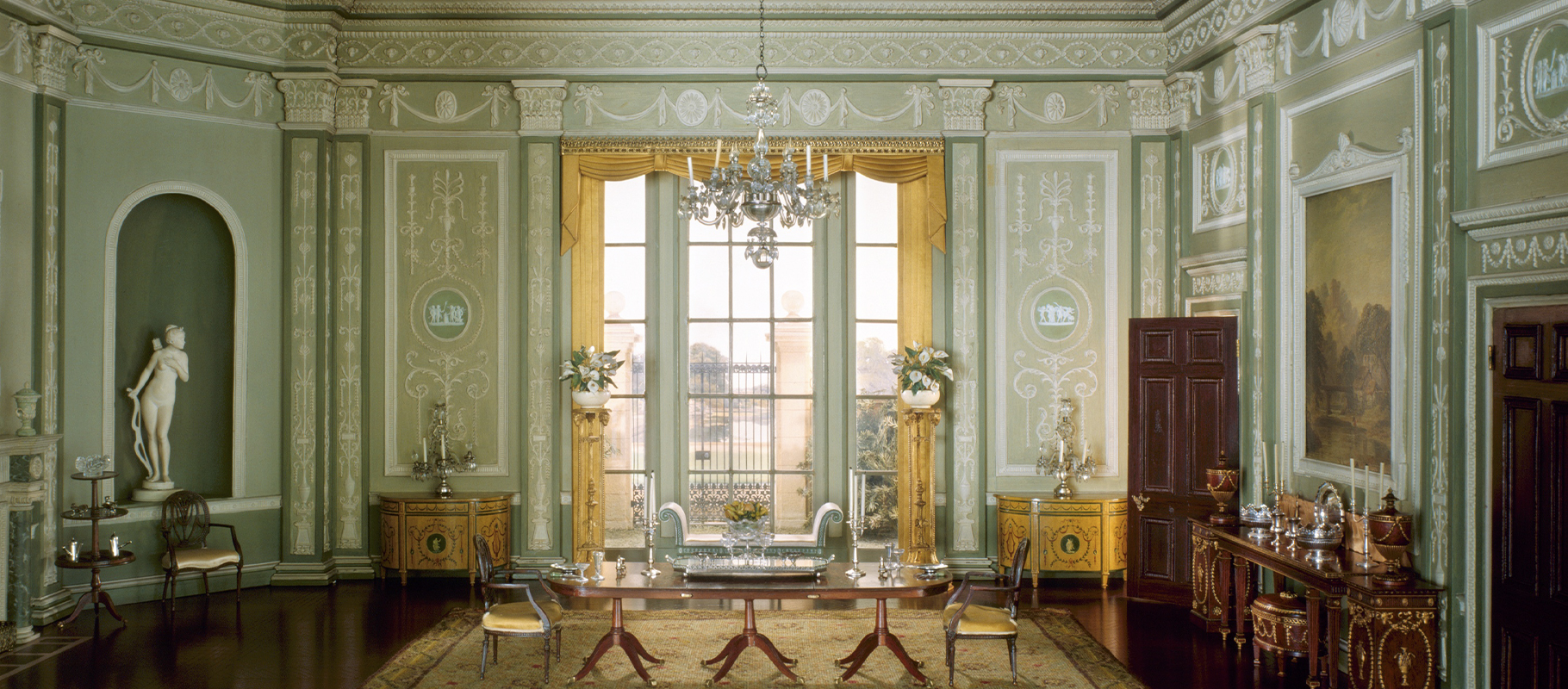 Above: a recreation of a Robert Adam dining room in miniature form
Above: a recreation of a Robert Adam dining room in miniature form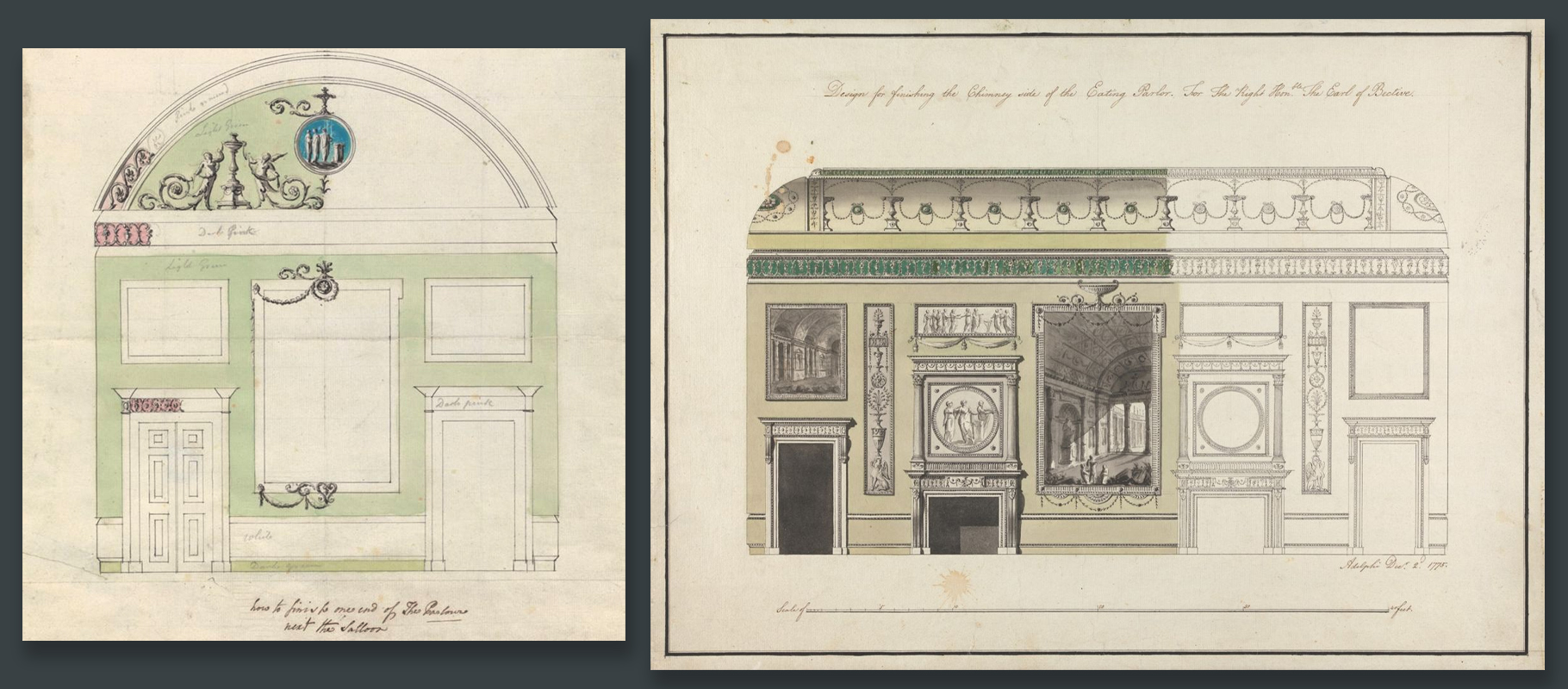 Above: two interior designs for Headfort House by Robert Adam, 1771-75
Above: two interior designs for Headfort House by Robert Adam, 1771-75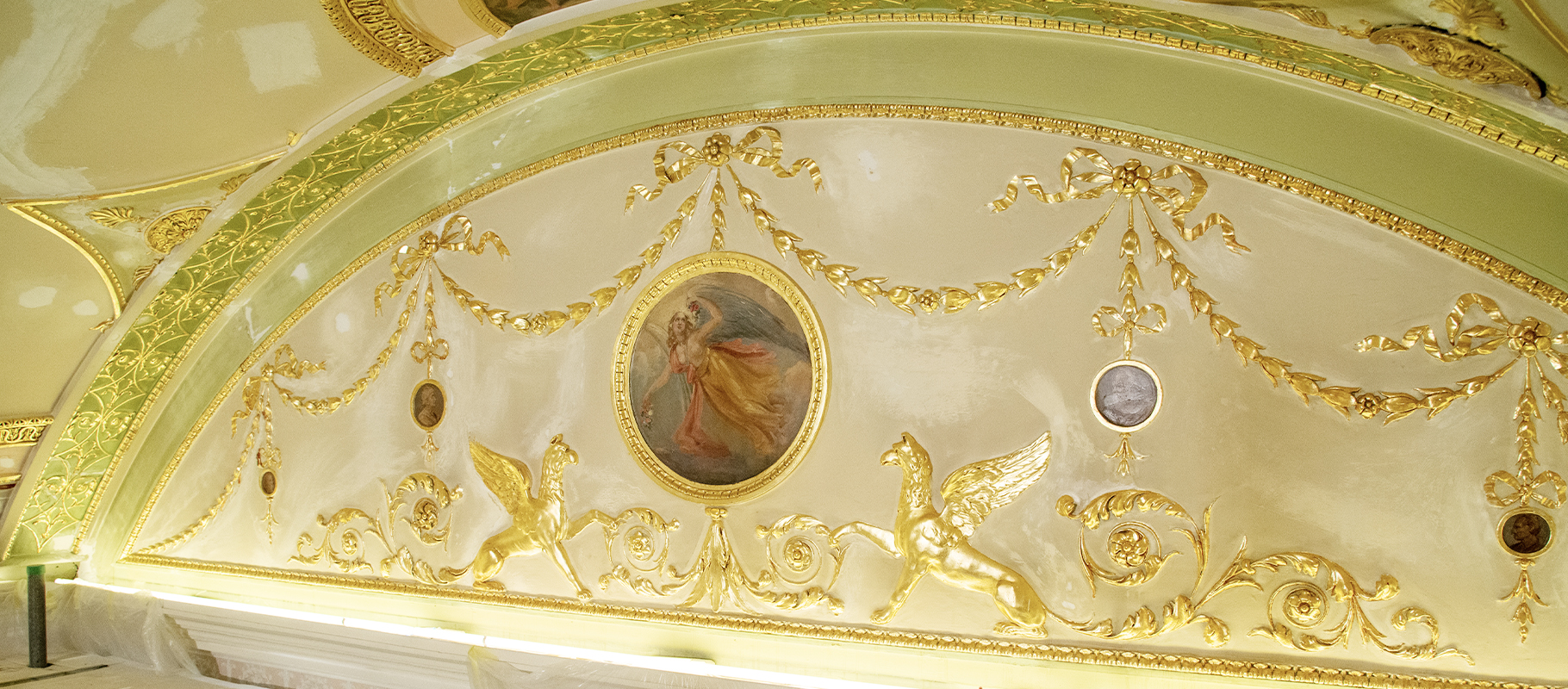 Above: a detail of the ceiling containing the figure of victory and four profiles of ancient philosophers
Above: a detail of the ceiling containing the figure of victory and four profiles of ancient philosophers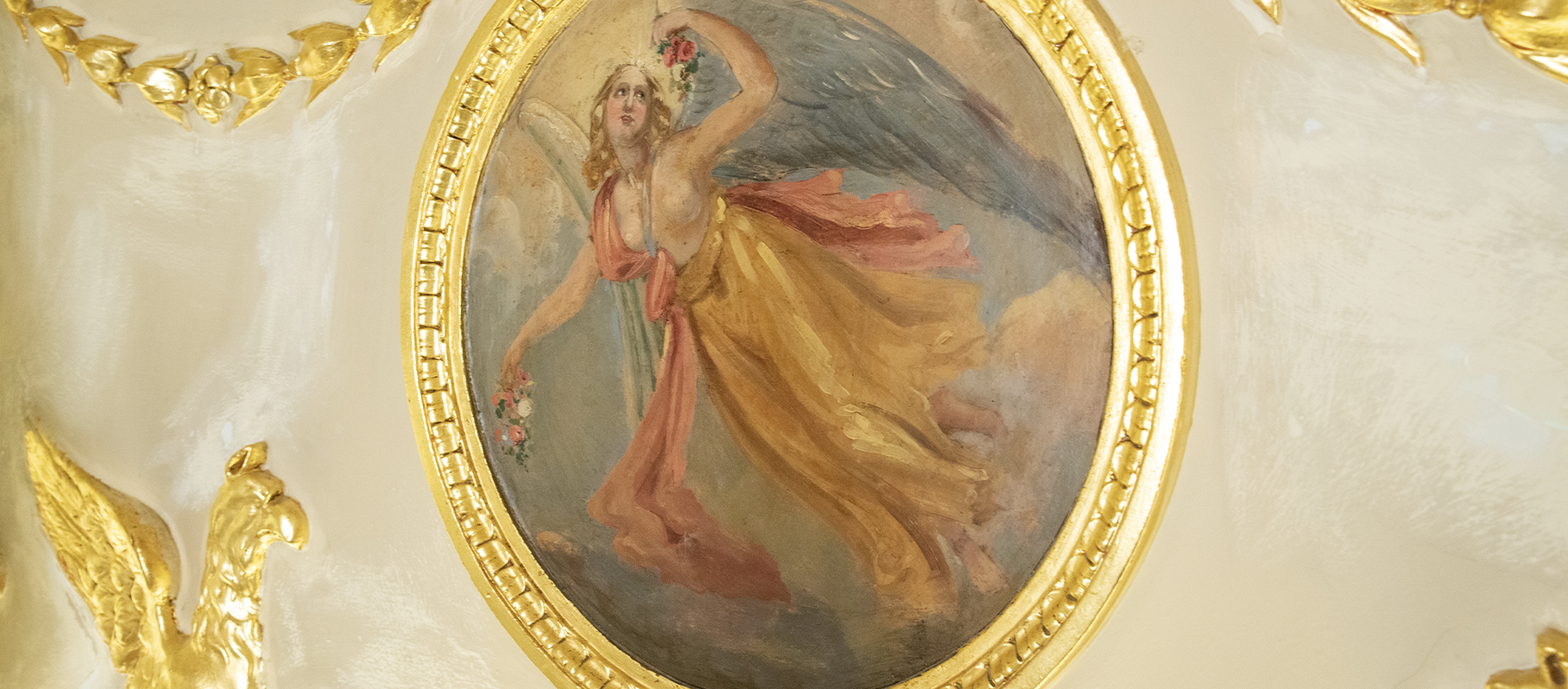 Above: the mural of Nike – goddess of victory
Above: the mural of Nike – goddess of victory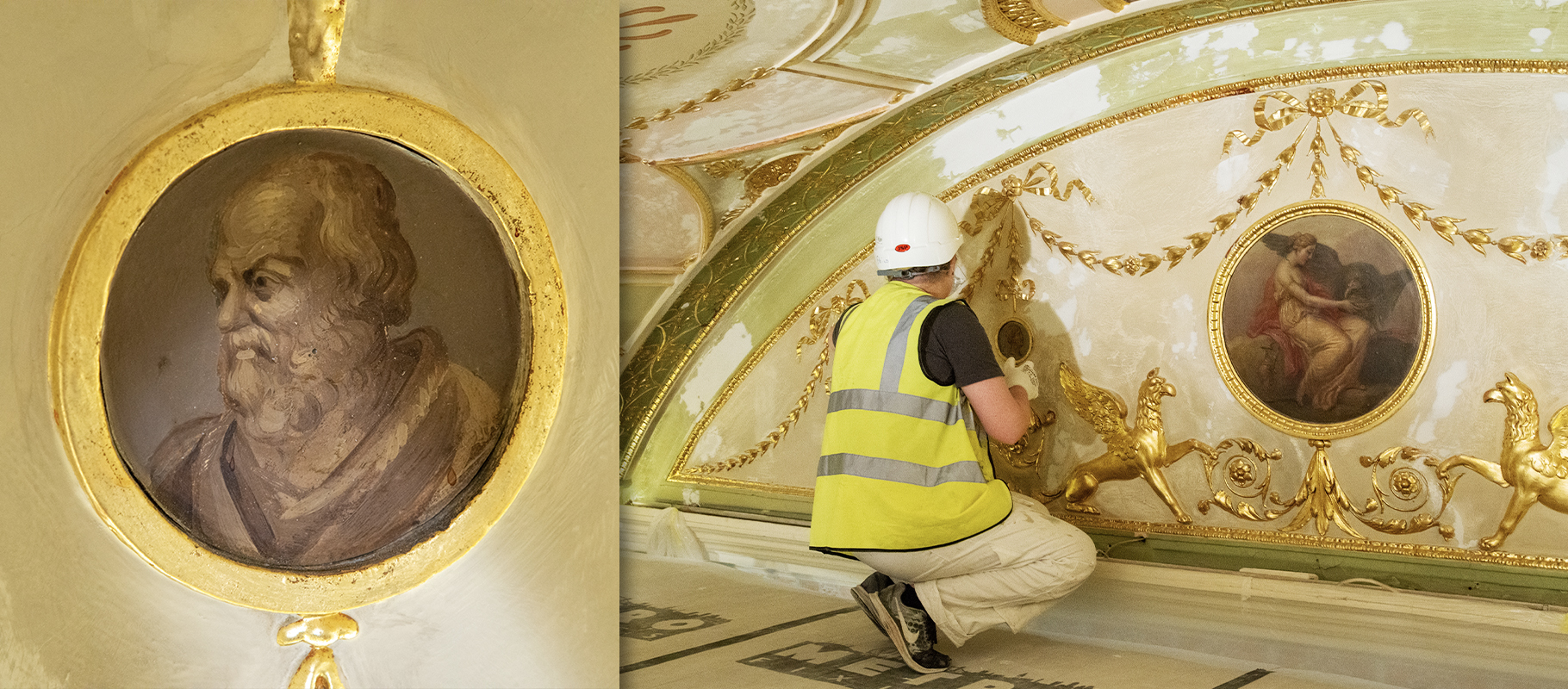 Above: roundels containing a philosopher and the goddess Hebe with Zeus in the form of an eagle
Above: roundels containing a philosopher and the goddess Hebe with Zeus in the form of an eagle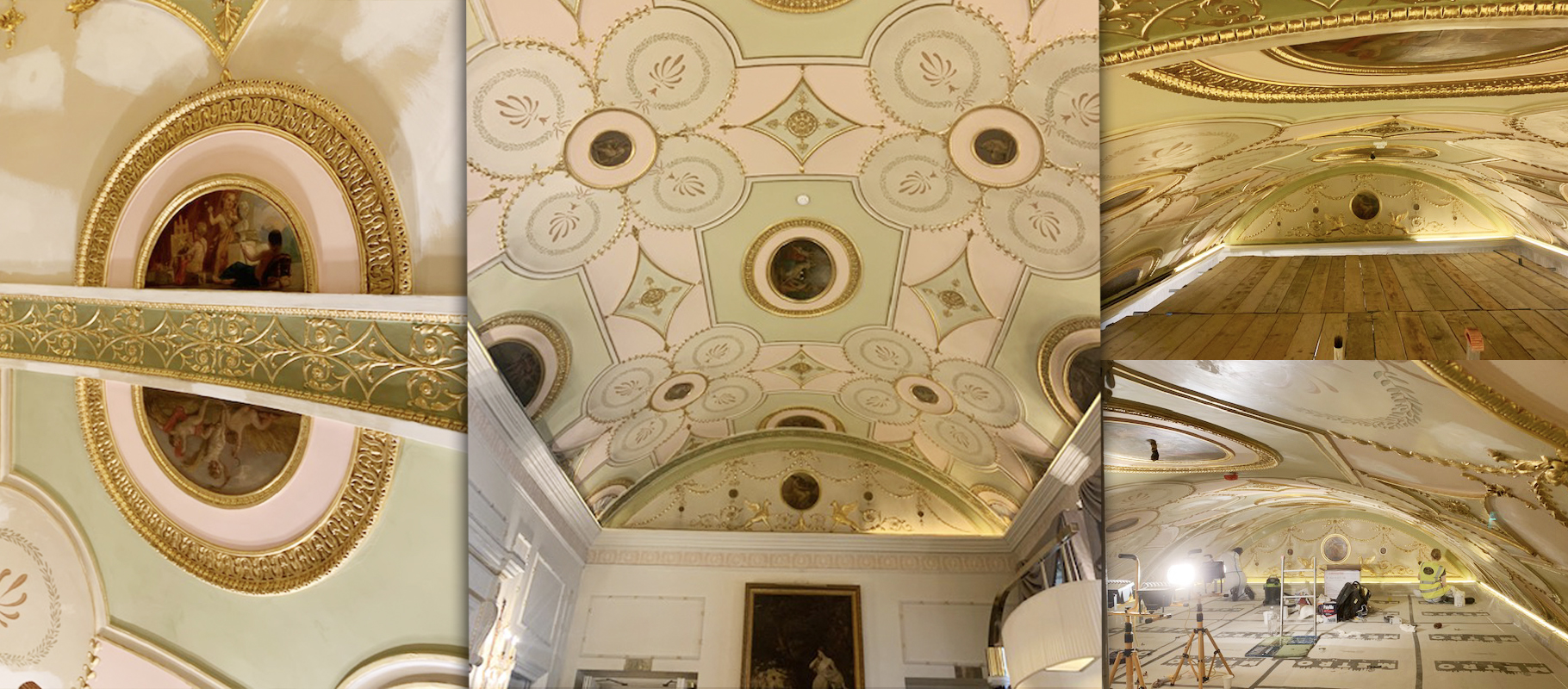 Above: the ceiling of the Bohemian Room at 30 Curzon Street
Above: the ceiling of the Bohemian Room at 30 Curzon Street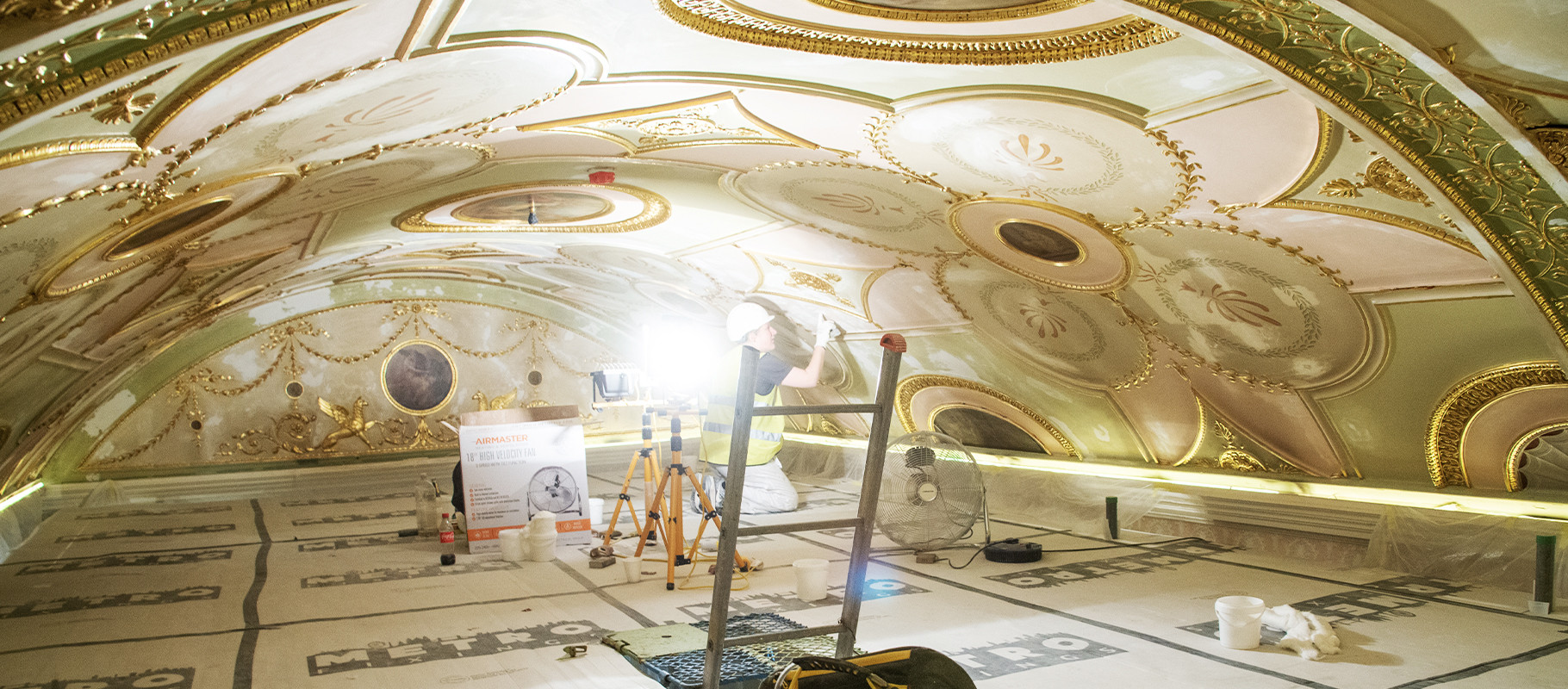 Above: our conservator working on the cracked areas of paint
Above: our conservator working on the cracked areas of paint Above: a painted roundel being stabilised, tested and cleaned
Above: a painted roundel being stabilised, tested and cleaned Above: photographs of the work in process, taken by our conservation team onsite at 30 Curzon Street
Above: photographs of the work in process, taken by our conservation team onsite at 30 Curzon Street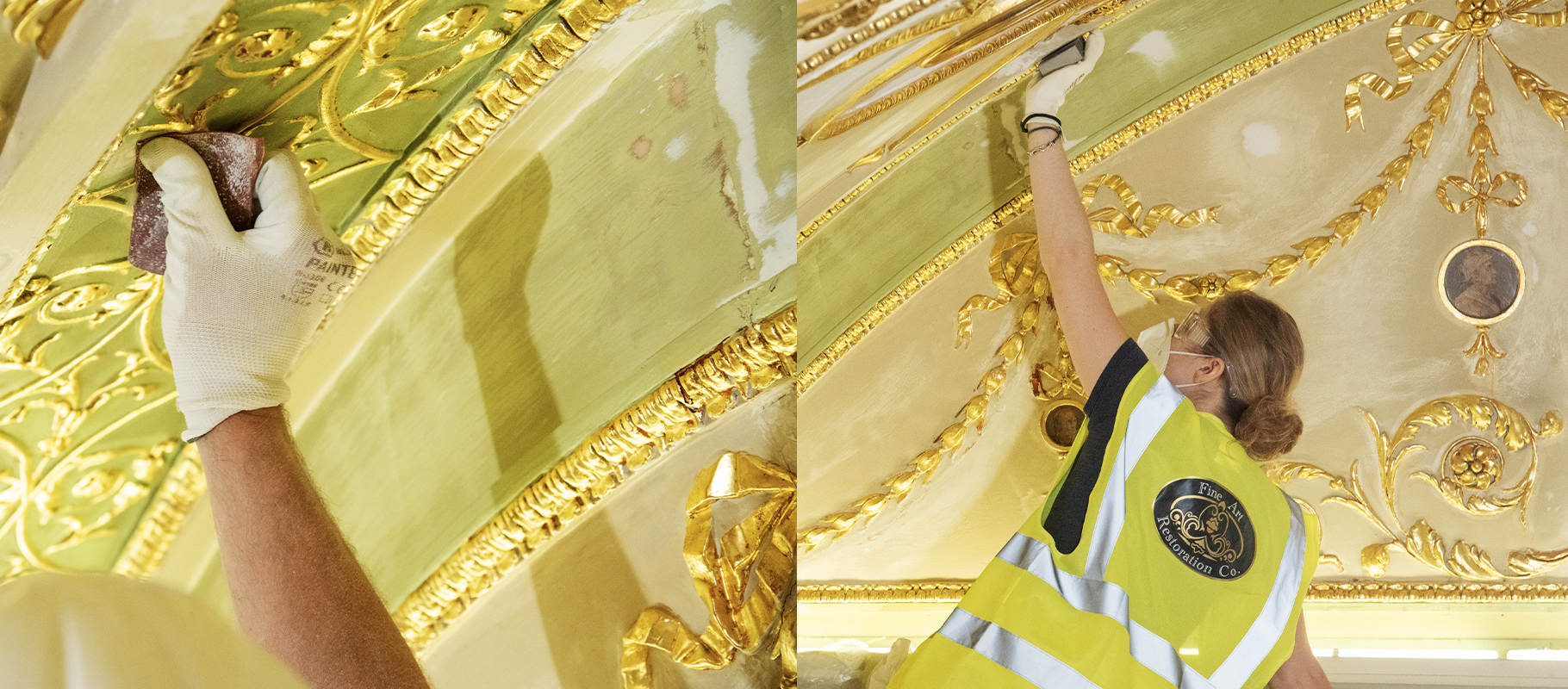 Above: intricate decorative elements being addressed prior to gold leaf restoration
Above: intricate decorative elements being addressed prior to gold leaf restoration




